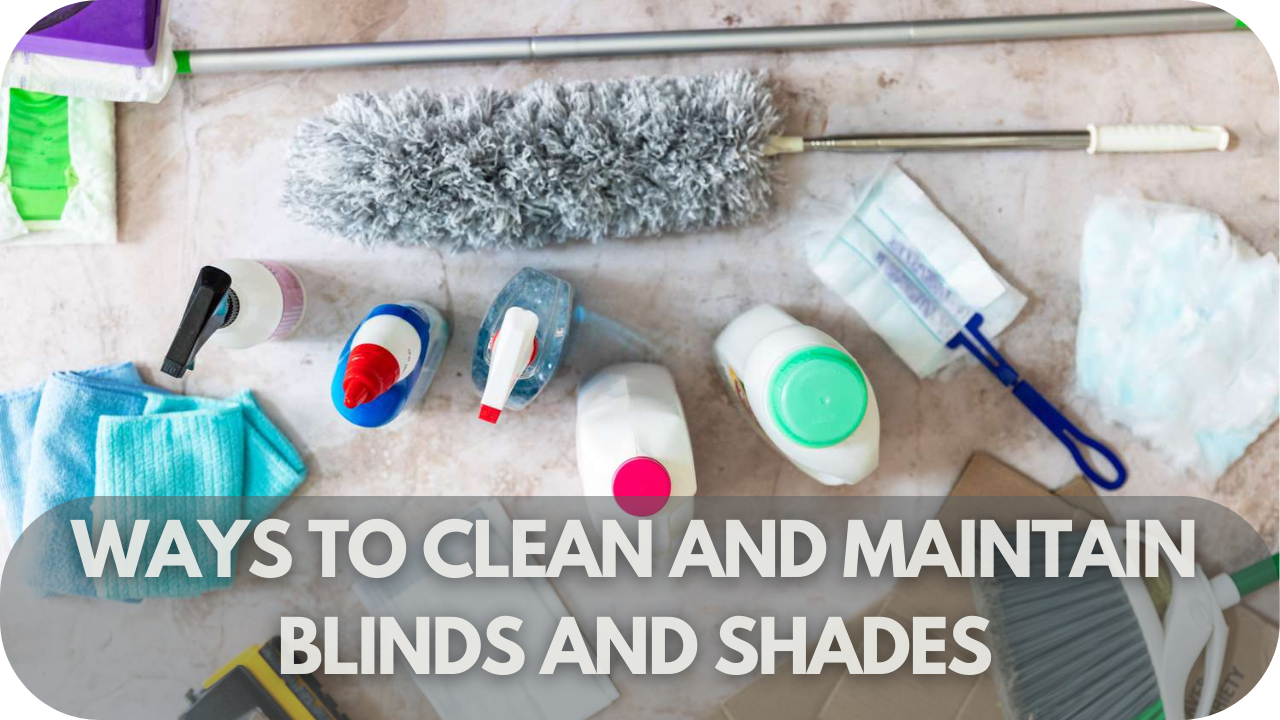After a few months of admiring my freshly installed blinds, I noticed the dust building up. It wasn’t long before the blinds, once crisp and bright, started to lose their charm.
Cleaning them seemed daunting, but after trying several methods, I discovered how simple it can be. Regular maintenance makes all the difference whether you have wood, faux wood, or fabric shades.
In this article, I’ll share the best cleaning tips that worked for me and how to keep your blinds looking brand new for years to come.
General Cleaning Tips for All Blinds and Shades
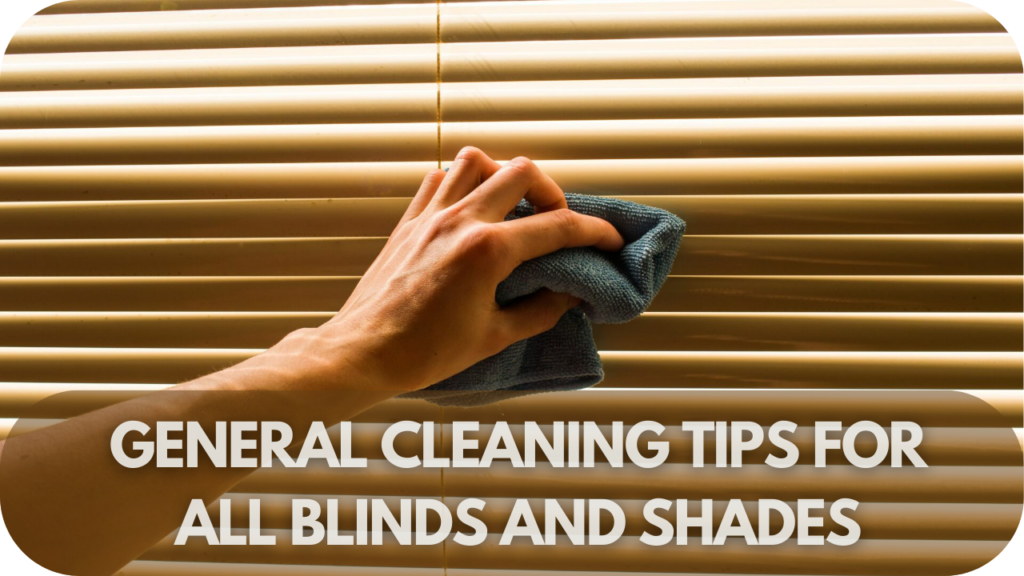
Here’s how to clean and maintain all blinds and shades with general tips on dusting, using mild soap, wiping carefully, avoiding harsh cleaners, and ensuring thorough drying to keep them looking their best.
- Dust Regularly: To maintain clean blinds, it is ideal to dust them every one to two weeks. Use a soft microfiber cloth, feather duster, or a vacuum with a brush attachment. This prevents dust build-up, which can make cleaning harder later. Remember to dust both sides of the slats or fabric to remove all debris.
- Use Mild Soap: Mix mild soap with warm water and wipe down the blinds with a soft cloth for more persistent stains. Be sure to keep the fabric neat, especially for wood blinds, as excess water can cause warping or damage. Clean any dirt or stains, focusing on areas that collect more grime.
- Wipe in the Direction of Slats or Pleats: Always wipe toward the slats for blinds or the pleats for shades. This helps preserve their structure and prevents damage. Wiping against the grain can cause misalignment or creases that may be difficult to correct.
- Avoid Harsh Cleaners: Avoid abrasive or harsh chemicals, as these can discolour or damage your blinds. Use only mild, non-abrasive cleaning solutions to protect the finish of materials like wood, fabric, or vinyl. Overly aggressive cleaning products may cause irreversible harm.
- Dry Thoroughly: After cleaning, ensure the blinds are dried properly. Moisture left on materials like fabric or wood can lead to water spots, warping, or even mould growth. Use a soft towel to gently wipe down the slats or let them air dry thoroughly before readjusting or raising the blinds.
How to Clean Different Types of Blinds and Shades
Cleaning different types of blinds requires specific techniques based on the material. This guide provides step-by-step instructions for Venetian, wooden, roller, Roman, and cellular blinds, ensuring proper care for each type.
1. Venetian Blinds (Aluminium and PVC)
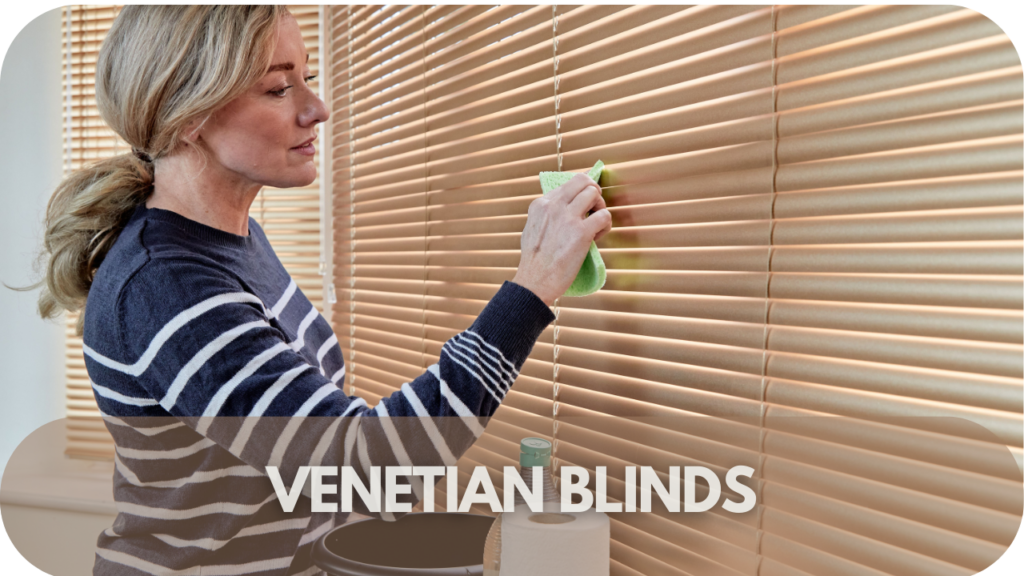
To clean Venetian blinds, vacuum with a brush attachment to remove loose dust. Then, use a damp microfiber cloth to wipe each slat individually, ensuring the fabric isn’t too wet to avoid watermarks.
For kitchen blinds, greasy build-up can be tackled with a mild detergent and warm water solution. For stubborn stains, try using a diluted vinegar solution. Always dry the slats thoroughly afterwards to prevent water damage or streaking.
2. Roller Blinds
Roller blinds can be maintained by vacuuming them with a brush attachment. Use a damp cloth with mild soap for minor stains, wiping gently without over-saturating the fabric.
Blackout blinds may require a fabric-safe stain remover for tougher stains. Apply it carefully to avoid damaging the blackout layer, and be gentle while removing stains to ensure the material isn’t damaged.
3. Wooden Blinds
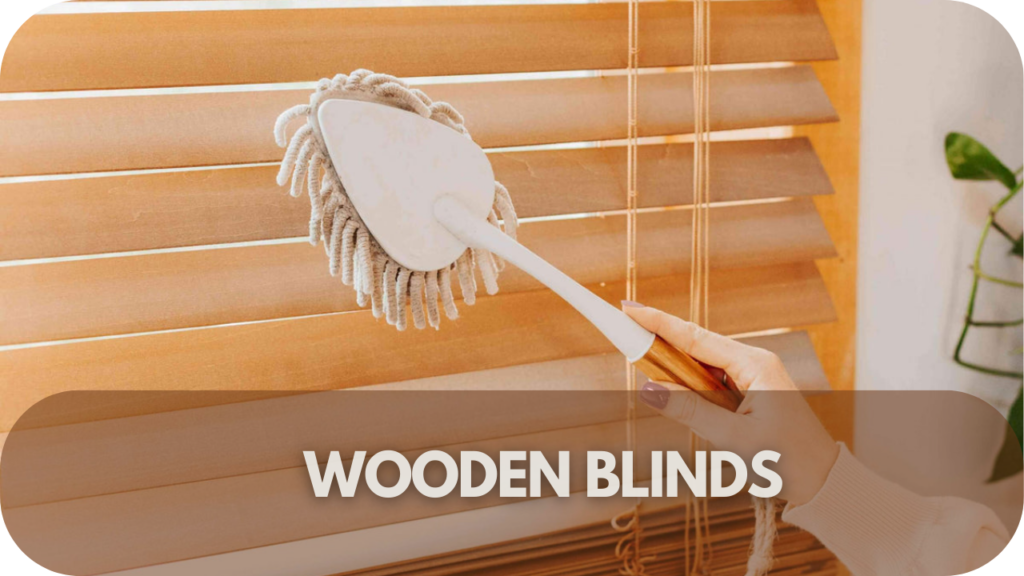
Regular dusting is essential for wooden blinds. To remove dust, use a feather duster or vacuum with a soft brush attachment. For a deeper clean, wipe with a lightly dampened cloth using a wood-safe cleaner.
Avoid excessive moisture, as it can warp the wood. Immediately dry each slat with a towel to protect the wood’s finish and prevent warping or water stains, ensuring the blinds retain natural beauty.
4. Roman Blinds
Delicate Roman blinds, especially those made from fabric, are best cleaned by a professional. Use a vacuum with a brush attachment to gently dust the fabric for routine care. If spot cleaning is needed, use a slightly damp cloth with mild soap, carefully dabbing the fabric to avoid soaking or damaging it. This method works well for light dirt without risking harm to the material.
5. Cellular Shades
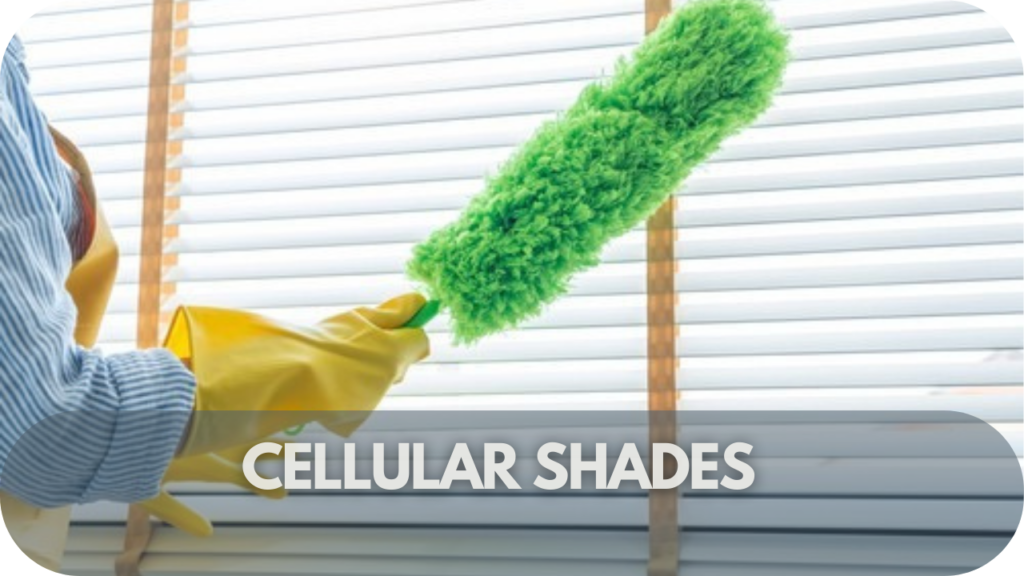
Cellular shades can be cleaned with a vacuum and a brush attachment. The vacuum should be run gently over the surface to lift dust without damaging the honeycomb structure.
Compressed air or a cool hair dryer can blow out dust or cobwebs trapped inside the cells. This approach keeps the shades clean without compromising their structure.
6. Sheer Shades
Sheer shades, crafted from delicate fabric panels, need careful handling to maintain their appearance. Dust them regularly with a feather duster or a vacuum equipped with a soft brush attachment.
For stains, gently spot clean using a mild detergent and a soft cloth, avoiding soaking the fabric. Excess moisture can damage the shades, so always allow them to air dry thoroughly before adjusting them. Proper care will help these shades retain their elegance and functionality.
7. Pleated Shades
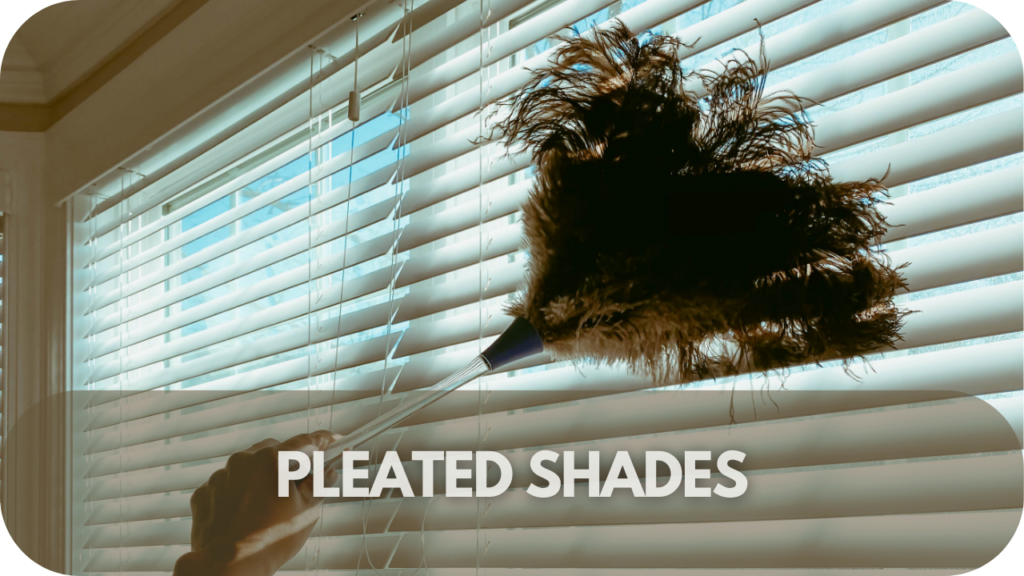
Pleated shades, known for their crisp, folded fabric, require gentle care to avoid damaging the pleats. Regularly dust them using a vacuum with a soft brush attachment, taking care not to crush the folds. For any stains, spot clean with a lightly damp cloth and mild soap, but avoid soaking the fabric to prevent warping. Once cleaned, allow the shades to air dry fully to maintain their neat, structured appearance.
Deep Cleaning and Maintenance
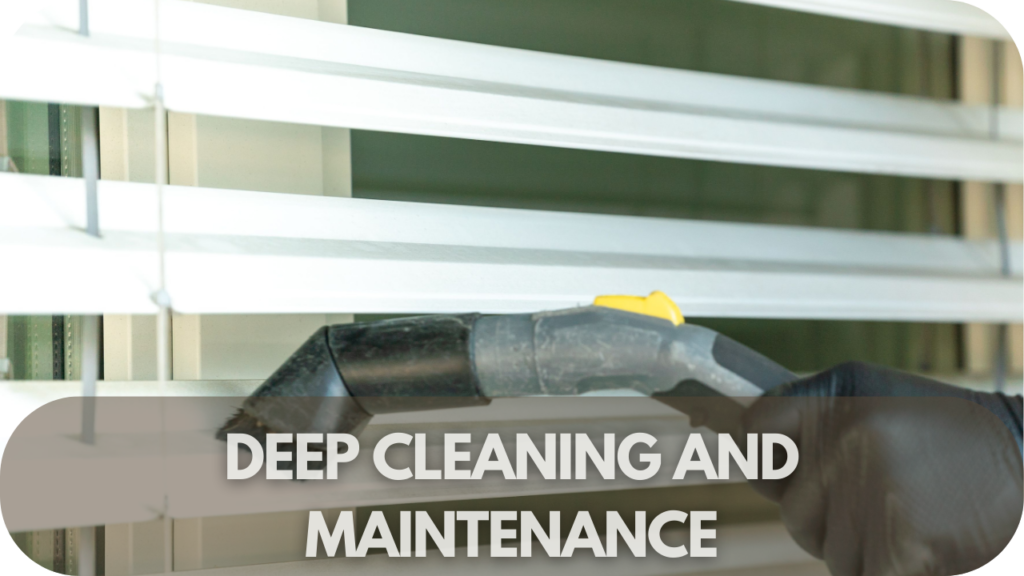
Deep cleaning of your blinds or shades is essential for tackling built-up grime and maintaining longevity. Blinds with heavy dust or dirt accumulation often must be removed and thoroughly washed.
For vinyl or aluminium blinds, fill a bathtub with warm water and mild detergent, soaking the blinds for 15–20 minutes before gently scrubbing with a soft sponge. Rinse them with clean water and let them air dry completely before rehanging.
Wooden blinds, however, require special care. Avoid soaking or using excess water, as moisture can warp the wood. Instead, use a dry or slightly damp cloth with wood cleaner, and always dry immediately to protect the finish.
Fabric blinds, such as Roman or cellular shades, may benefit from professional cleaning. However, spot cleaning with a mild soap and vacuuming can handle regular upkeep. Maintenance is also key—regular dusting, cleaning chains, and lubricating mechanisms can prolong the lifespan of your blinds.
When to Consider Professional Cleaning or Replacement

There are times when more than routine cleaning is needed for blinds. This section covers when to consider professional cleaning for delicate fabrics or replacing blinds due to wear, malfunction, or irreparable stains.
- Professional Cleaning for Delicate Fabrics: Blinds made from delicate fabrics like Roman or cellular shades should be professionally cleaned to avoid damage from at-home methods, especially if they have intricate designs or are prone to wrinkling.
- Stubborn Stains or Significant Dirt: If your blinds have stubborn stains or significant dirt build-up that cannot be removed through routine cleaning, professional cleaning can restore their appearance without causing damage.
- Signs of Wear and Tear: If you notice visible signs of wear, such as broken slats, discolouration, or warping, consider replacing the blinds. These issues often affect wooden or faux wood blinds and hinder their functionality.
- Malfunctioning Mechanisms: When blinds no longer open, close, or tilt properly, or if their cords and mechanisms are frayed or broken, it may be more practical to replace them rather than repair them.
- Fraying or Discoloured Fabric: Fabric blinds with frayed edges, faded colours, or noticeable fabric damage might need to be replaced to maintain aesthetics and functionality.
Conclusion
Keeping your blinds clean not only maintains their look but also prolongs their lifespan. By following the right steps for each type, you can enjoy spotless, functional window treatments year-round.
Still unsure? Let Into Blinds, Australia’s most trusted, handle it for you. Book a consultation today and see the difference expert care can make!

